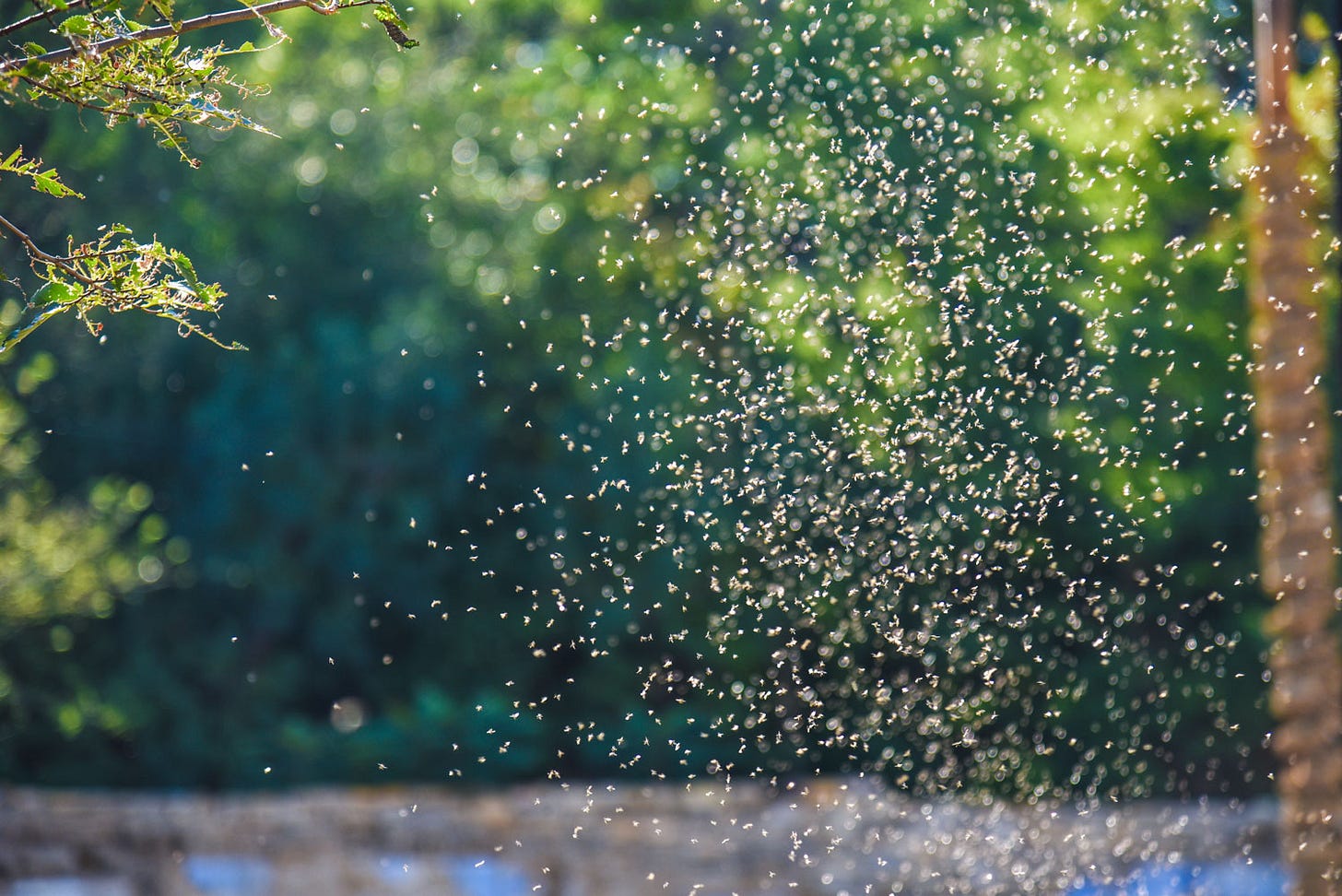Last week I was outside as the sun was setting, looking across the lake as our kids’ mountain bike team practiced, when I noticed gnats swarming in the evening light. But there was something odd about them – they were swarming in vertical columns, about three columns spread over 50 feet or so. And even weirder – if I watched them long enough as they would dip and turn and dance around each other, at some point the entire swarm seemed to jump simultaneously.
It happened so quickly I wasn’t sure if it had been an illusion, but with careful studying I saw it happen several times. The only way I can describe it is how the picture on an old reel-to-reel movie screen will jump when there’s a blip with the film roll.
Or maybe it was a glitch in the matrix.
You can see it in this video I found in a research paper – watch closely and don’t blink, and about 3 seconds into the video all the mosquitoes lurch upward in synchrony.
What’s happening here?
Can gnats synchronize their flight patterns?
When animals move together, as with schools of fish or flocks of starlings, this “collective behavior” can make hundreds of individuals appear as if they’re moving as one organism. It’s fascinating to see the silvery flash of fish organize into a “bait ball” as a way to scare off predators, as you can see in this BBC Blue Earth video (click image to play):
The fish are so coordinated they almost form a solid substance, swimming and shifting together to ward off the larger fish looking to eat them.
Flocks of birds can also move in concert, creating a flowing dance in the sky called a murmuration as they respond to slight shifts in the environment. Individual birds make slight changes in midflight, which their neighbors and then THEIR neighbors must respond to in order to avoid crashing. The result is a fluidity of movement that turns individuals into one large, pulsing organism (click image to play):
The beauty of these starlings and fish, as well as migrating herds of caribou and other animals engaging in collective behavior, is the massive coordination happening with hundreds or even thousands of animals that we’re used to seeing as singular beings.
Insects, on the other hand, aren’t nearly so coordinated. Gnats and mosquitoes and midges will create a swarm, but they aren’t all flying in the same direction. If you study them, they appear to be randomly flying within a small area, like frantic last-minute shoppers buzzing around the mall on Christmas Eve. This randomness is what made their sudden coordination so surprising to me – why would they suddenly become organized for a short second before reverting back to chaotic flight?
It turns out there’s a bit more organization in an insect swarm than I thought. To begin with, it’s only males who swarm. They’re convening together to make themselves available to the females, who dip in and out of the swarm in order to mate. If you watch the video of mosquitos at the top of this newsletter, you’ll see a few mosquitos enter from one side or the other and simply fly through the swarm without taking part – those are the uninterested females. Apparently, if you encounter a swarm of insects, they are most likely males. That’s good news with mosquitos because it’s the females who bite us – males just eat fruit juice and nectar.
When males fly in their swarm structures, I learned they usually fly in small circles horizontal to the ground since that conserves their energy relative to gravitational pull. They’re essentially flying in multiple little loops, over and over, avoiding their neighbors by listening to the sounds of their wings. Here’s the flight pattern of one mosquito, as observed by looking down through the swarm:
So far, so good. Insects are slightly more organized than I thought, with their circular flight patterns and tightly wound swarms.
But what about the weird synchronized fluctuations, where suddenly the swarm appears to coordinate, everyone jumping at the same time? Insects aren’t supposed to act like starlings or balls of bait fish, right? But somehow, they are. However fleetingly.
Unfortunately, scientists don’t have a ton of answers here. They are still working out their theories for how males and females find each other in these swarms, as well as how their flight patterns move in ways like liquids and gases. One article, published earlier this month, mentioned that within an insect swarm a subgroup can synchronize and create a “local order” as an accidental by-product of an environmental fluctuation. That’s the closest I could find to a description of what I’ve seen, but I can’t get access to the full article because it’s so new. Then again, I’m not sure I’ll even understand it once I do because it references concepts from physics I’m not familiar with like cooperative ring exchanges tied to quantum fluid states.
At its most basic, it appears that while individuals in insect swarms are flying their tiny, horizontal, circular loops, the overall mass is not coordinated until some type of outside stimulus occurs – perhaps a change in wind, the appearance of another species, or even a slight change in light or shadow. At that point, enough insects engage in “mutual repulsion” to communicate to the swarm the presence of danger or at least something new. The group instantly reacts, then resumes its chaotic flight pattern.
Have you ever noticed this? Next time you’re outside at dusk, look for a swarm of gnats congregating in the light (they do this to make it easier for the females to find them — they’ll move with the beam of light if they need to). If you watch them closely, do you see a sudden fluctuation when they all jump at once?
I’d love feedback on this, if you’ve seen this in the wild or if you’re a biologist/entomologist who has insight into exactly why this happens.
Weird Nature:
(click to watch)










Most males of flies (Diptera) in the suborder Nematocera have plumose, i.e. featherlike, antennae. These have usually been interpreted as sound receptors, with the common claim that they resonate in response to the female's wing tone frequency. There is evidence for this in some species. As you wrote, the male swarm has the advantage of ease of location by females, even though each male will have only a 1 in xxx chance of mating with each arriving female. But his chances must still be higher than "going it alone." Male swarms locate themselves over landmarks, and these can be simply bright spots, as in the top video, or they can be lights, as you noted. Each male seems to locate himself independently of the others, as the figure of the looping flight track shows. It is still possible that this orientation is also modified by the position of other males--- hard to tell.
But here is a fun and possibly relevant observation. My father often saw midge swarms in the back yard, dancing over some landmark. He found that if he made a high pitch bzzzt sound, all the midges bounced (just like your top video). He could do it repeatedly. I got it to work for me sometimes, but not as reliably as he did. The implication is that the "bouncing" is in response to sound, and the sound perhaps (this is my hypothesis) resembles a very large female midge from a very general direction, so all the males move quickly in that general direction. Keep in mind that the female's wing tone would be much quieter and more local. My hypothesis implies that if the bzzzt came from different directions, the males should bounce accordingly. There should be a correlation between the sound source and the bounce direction, though not necessarily in the same direction. A research project looms....
So, next time you see a swarm, give it a try. It might work better after a gin and tonic, but who knows. Let us know how it goes.
For those not in the know, Walter is a recognized authority in the field of Myrmecology and his books on the stunning architectures of ant nests and on the fire ants combine scientific insight with witty and graceful writing. I own both and can highly recommend them. To have him as a commentator, means alot! Glad I found this place!